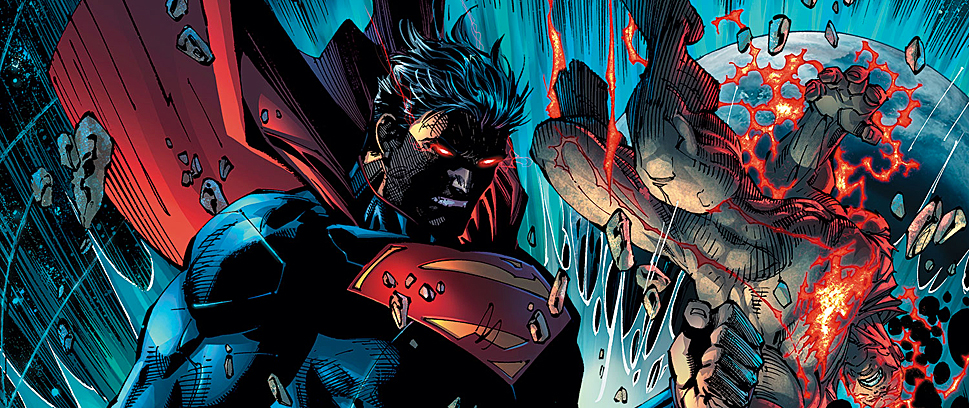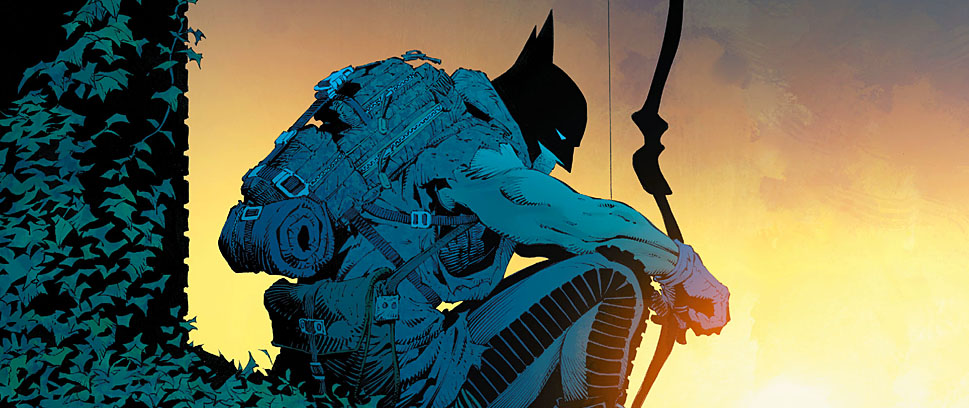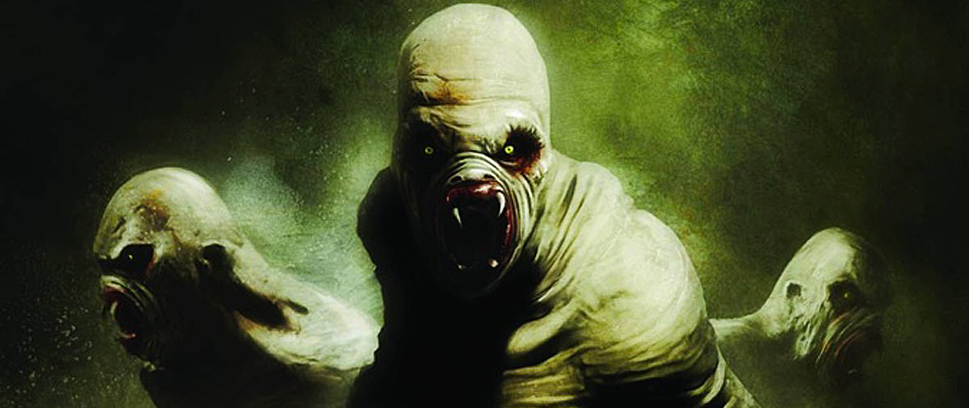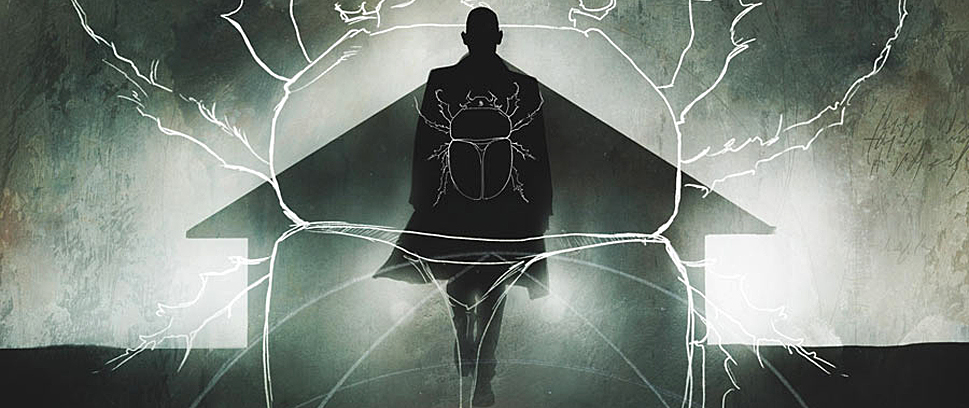
Last Week’s Comics 9/17/2014
Superman Unchained #8
(DC – writer: Scott Snyder; art: Jim Lee)
The key to writing good Superman stories is finding the one part of the character that truly defines him. Superman is always known as the man who can fly, and everyone is aware of his super abilities. So even a superhero throwdown isn’t enough to really excite me – we see it all the time. But Scott Snyder finds a way to make Superman’s battle with Wraith a doorway to his character, and what he reveals saves the comic from being just another story about Superman battling an unstoppable enemy.
 The majority of the comic is Superman trying to defeat Wraith. From the sands of the Gobi desert, to outer space, to the area between the upper and lower mantle of the earth’s crust, he tries everything to bring down an enemy who can physiologically adapt to any situation, and this is where Snyder makes his mark. While battling Wraith, Clark is asking himself what Diana or Bruce would do. With Wonder Woman, Clark sees her all about being a warrior. But with Batman, Clark sees Bruce as someone who fights “dirty.”
The majority of the comic is Superman trying to defeat Wraith. From the sands of the Gobi desert, to outer space, to the area between the upper and lower mantle of the earth’s crust, he tries everything to bring down an enemy who can physiologically adapt to any situation, and this is where Snyder makes his mark. While battling Wraith, Clark is asking himself what Diana or Bruce would do. With Wonder Woman, Clark sees her all about being a warrior. But with Batman, Clark sees Bruce as someone who fights “dirty.”
Each internal conversation leads to a revelation, and each revelation brings Clark closer to victory. So when he finally brings Wraith to an area where he can fight, Superman finds a way to defeat his enemy. What’s more interesting about the battle is what Snyder reveals about Superman. Yes, he has a ton of powers, but beyond that he’s learned how to fight. Imagine being best friends with Batman. I think you’d pick up a thing or two.
But it’s like Snyder couldn’t leave well enough alone, and when the real enemy is revealed, we shift into the final phase of Superman Unchained. Up to this point, the pacing of the issue was good (as most of it was fighting), but the extensive denouement defeats the climax before it has time to settle. Instead, we’re off to a new problem before the first one has even resolved. I would have preferred a tease of Superman’s real enemy rather than an exposition-heavy disclosure by the world’s greatest mastermind. At this point, the character has had a great epiphany; the rest of the issue detracts from that.
Surprisingly, Jim Lee’s art lacks its usual sharpness. It’s hard to tell exactly what it is about the visuals, but they’re not as polished as we’ve seen in the past. While the shot of Supes flying Wraith into the outer atmosphere is superb, the rest of the comic isn’t as dynamic.
Superman can’t be an easy character to write, but Scott Snyder is more than capable of defining what it is about the man that makes him the world’s best-known superhero. And despite the climax, I’m intrigued to see how Clark will figure out his latest jam. We know he’s capable because we’ve seen him overcome major obstacles before, but I’m curious how Snyder will do it. The guy’s definitely known for pulling fast ones.
I’ll be back next month to see how this turns out.
———
Hawkeye #20
 (Marvel – writer: Matt Fraction; artist: Annie Wu)
(Marvel – writer: Matt Fraction; artist: Annie Wu)
Hawkeyeis a book that never takes itself too seriously, even when it has serious stuff to deliver. Not that Fraction’s finale to Kate Bishop’s tale is dour by any means, but it definitely offers up a pretty surprising climax to Kate’s continuous run-ins with Madame Masque. While the narrative can be a bit choppy, Annie Wu’s artwork is gorgeous, and the end result is a comic that wraps up Kate’s West Coast adventure while dovetailing nicely with Clint Barton’s story back home in New York.
Kate is telling her story in the past tense, so Fraction bounces back and forth quite a bit. This leads to a bit of a disjointed narrative thread, and if not for Wu’s clear delineation of the past and present, I might have gotten lost in the transition. The present Kate is bruised and bandaged, so the lead-up to her injuries is methodical and confident as Fraction peels back the story layer by layer until we see how our heroine ended up so battered.
But Fraction’s usual lightheartedness makes the comic a fun read. Kate as a lead is always clever (maybe a bit too much at times), sharp, funny and amiable. Her cheerfulness is infectious, and that’s what makes Kate’s discovery all the more powerful. When she sees who’s been financing Madame Masque’s operations, Kate’s world changes drastically, and the opening scene – where we see one side of a conversation – makes a lot more sense for the final page, where Kate calls someone she knows and loves and tells him that she’s learned what he’s really doing with his money.
Annie Wu’s art is really the start of the issue. Every page is sharply illustrated, and Wu knows how to match Fraction’s timely humor with a goofy face or a deadpan one for that matter. She definitely offsets the Kate who didn’t know a secret with the Kate that does. The past Kate is still playful and buoyant, while the present Kate is defeated and tired. She just looks beat, and you can understand why by the end of the issue. Plus, Matt Hollingsworth’s colors help sell the tone Fraction communicates to Wu. The
entire artistic team works in tandem to deliver another solid issue in a series that hasn’t failed to amaze.
Hawkeye #20 brings its tangent back seamlessly. What we’ve learned, though, is that Kate Bishop is every bit as heroic as Clint Barton, and if need be, she could easily survive in her own series. Where we’ve seen, more and more, men showing a lack of respect for women, we should be thankful for people like Matt Fraction. The man knows how to write a strong heroine, making her powerful, intelligent and fierce. He’s clearly defining Kate Bishop as a role model for women.
———
Batman: Futures End #1
 (DC – writer: Ray Fawkes and Scott Snyder; artist: Aco)
(DC – writer: Ray Fawkes and Scott Snyder; artist: Aco)
In another world, Batman’s greatest intellectual rival would not be Ra’s Al Ghul, but Lex Luthor. Or maybe this is what the future looks like?
It’s five years in the future this month at the carnival that is DC, and the ride is called “Futures End.” Bruce Wayne is old and nearly completely broken. He sports an exo-spine and can only suit up as Batman with a cocktail of pain killers and stimulants and a special suit that will hold his frail self together. Wayne is trying to find a way to make sure he stays Batman forever, and cloning seems to be the answer. Problem is, the solution Wayne needs is locked up in one of LexCorp’s labs.
Batman doesn’t match wits with a physical Luthor, but faces him in the guise of one of his security systems. An ever-present hologram of Luthor (is it live or a recording?) taunts the intruder and questions how anyone could best his system, theorizing it could be Luthor himself.
I’ve recently come across the terms “head canon” or “personal canon,” but the theory is something I’ve been practicing as long as I’ve been a comic book fan. Hey, I’m a Luddite in many ways and miss out on lots of things in the greater pop culture-verse. Basically, personal canon boils down to: what makes sense to you as the uber-fan of a particular universe, no matter what “officially” happens that you may disagree with, is your truth.
My personal Bat-verse borrows heavily from the respective works of Grant Morrison and Scott Snyder. Batman: Futures End (story in part by Scott Snyder) seems like a logical extension of either of their work. So, high marks on the issue from me. Batman, logically, should have a finite end. He’s a human being, after all. Per Morrison, Batman franchises himself out to physically fresh talent. With Snyder, I give much weight to his “Twenty-Seven” story, where an infinite stream of Batmen face their mortality and need to find a successor before passing the mantle.
Author Ray Fawkes and co-writer Snyder do their best to give some sort of closure at the end of this issue, but we are not in a world of “one and done” comics. To achieve real closure, one will have to read “Futures End” in its entirety, or at least hope our future has in store affordable trades for our preferred DC characters.
The ending does pull the heart strings. Alfred, ever the voice of reason in the Batcave, pushes Wayne to retire and consider the good he’s done to be the final statement on his life’s work. Wayne, never one to rest on his laurels, or really just a megalomaniac, remains singularly focused: “Gotham must always have Batman. No matter what happens to me. Always.”
———
Red Moon
 (Dark Horse – writer: Carlos Trillo; artist: Eduardo Risso)
(Dark Horse – writer: Carlos Trillo; artist: Eduardo Risso)
For years, comic books were derided by the mainstream media as entertainment for children, with articles about the medium often having headlines like “Biff Bam Pow!” and the like. Weirdly, I think that helped the good spaceship comic book move away from children’s entertainment at a pace comparable to light speed. Well, that and the fact that the majority of people reading comic books were adults who had stuck with it since childhood, with less and less new kid readers climbing on board. Simply put, comics for children were few and far between for a while. Which is why the fairy tale Red Moon is a breath of fresh air in a weird way, since it’s good comic book entertainment that’s targeted at children.
Dark Horse has released this hardcover collection of short tales centering around a half-fairy tween with fiery red hair and personality named Moon and the odd cast of fantastic characters that she goes on adventures with. Specifically, Antolin – an acrobatic boy her age who she embarks on her first major quest with to rescue her kidnapped father, the ruler of the Kingdom of Burien. Along the way they meet various talking animals, a woman who trains an army of cats, a tiny strongman and quintuplets who can become a human tower. The book gets much stranger than this, though, as Moon and Antolin also have adventures in a cursed land called Never and have to discover the secret of a giant’s weakness in another kingdom ruled by a witch named Yaga. It’s fun stuff, but definitely targeted towards a younger reading level.
The language in Red Moon is very simple and explanatory. For a kid it’s very effective (it says Age 8 on the Dark Horse website), although at times I was skipping blocks of conversation due to the repetitive exposition. Given Carlos Trillo’s output as a comics writer who wrote in a variety of styles, this seems to be intentional, and I must admit that I haven’t read a book targeted towards elementary school children since well, elementary school. There are some cute and funny moments mixed with scary and dramatic moments, all done effectively. Also, the world as a whole is fantastic, thanks in part to the cartoony and at times majestic artwork from 100 Bullets artist Eduardo Risso.
Out of all the stories, I enjoyed ones in the magical lands more than the straight-up quest stories, maybe because it gives Risso the chance to really flex his muscles. This is specifically true in the land of Never, where a foul witch has cursed the inhabitants with a variety of deformities and has fused a number of them with other animals. There’s a nice bit in this section about accepting yourself for who you are and not pretending to be someone or something else.
If you have a young comic reader in training I would highly recommend having them read Red Moon. It reminds me of the fantasy and fairy stories I read as a child, and there’s a level of love in the creative mix here. The violence is minimal, and the worst profanity is “sucks.” When I recommend comics to parents for their children I always have to take a second to think if it’s actually an appropriate read for kids, but that’s not the case with Red Moon, a fun fairy tale with a fiery energy to match that of its female protagonist.
Full disclosure: Dark Horse Comics provided Unwinnable with an advanced review PDF of this book. Red Moon hits the shelves today.
———
Batgirl: Future’s End #1
 (DC – writer: Gail Simone; artist: Javier Garron)
(DC – writer: Gail Simone; artist: Javier Garron)
As determinedly grim and gritty as DC Comics has been lately, nowhere is it grimmer and grittier than in the series, “Futures End.” Set in a possible future gone horribly wrong, (and which will come to pass for the rest of DC’s characters if Batman Beyond and a few others can’t change time) “Futures End” has so far struck me as an excuse for even more bleak characters and shock-value violence. So when DC announced that all of its September titles would take place in the “Futures End” time period to show what would happen to these characters if this terrible future comes to pass, I wasn’t thrilled.
Batgirl: Futures End #1 proved me wrong. This standalone story was certainly dark, but main character Barbara Gordon grew in interesting ways (both mentally and physically), and without losing sight of the compassion and dogged optimism that has come to define everyone who has worn the Batgirl mantle.
The issue begins two years into the future instead of five, with Barbara’s marriage to cop Steven Harris soon tragically interrupted by Barbara’s psychotic brother James Jr. By page 4, Steven was dead. Death of a loved one is a time-honored superheroic motivator, and that isn’t going to change anytime soon. Nor should it. Still, I did find it refreshing that this time it was a man’s death that motivated a woman hero, instead of the overwhelmingly frequent other way around.
Three years later, in the “Futures End” period, a team of three Batgirls defends the streets of Gotham: Stephanie Brown, Cassandra Cain [in her New 52 debut! (fangirl cheers)] and Tiffany Fox, daughter of Lucius and sister of the new Batwing, Luke Fox. I don’t know much about Tiffany, but one of her lines is a direct reference to the 1997 film Batman & Robin, which I unironically adore, so I already love her, too.
Directing the “League of Batgirls” is Barbara Gordon, now calling herself Bête Noire, an identity influenced by the unlikely combination of Oracle and Bane. Through flashbacks, writer Gail Simone fills us in on Barbara’s missing three years, leading up to a final showdown between Barbara and Bane, with the Batgirls never far behind.
Since Batgirl #1 in 2011, writer Gail Simone has developed a unique voice for her version of Barbara Gordon, and she keeps that voice consistent into the “Futures End” future, despite the many changes the character undergoes. Artist Javier Garron’s art style pairs well with Simone’s writing, using comic book art tropes such as black lines, background motion lines and stylized costumes (Barbara, what are you wearing) to convey a “classic” comic look. Garron also brings an attention to anatomical detail that is still frequently absent in depictions of women in comics. Some things were a bit wonky, but overall the art conveyed Barbara’s strength and personality.
But what I loved most about Batgirl: Futures End #1 (even more than Cassandra’s big return and the Batman & Robin reference) is the compassion and resilience of its characters, even in a city as bleak as “Futures End” Gotham. The issue is far from cheery, but instead of being fascinated with its own darkness, Batgirl: Futures End #1 is fascinated with the way heroes respond to darkness. If this is Gail Simone’s last time writing Batgirl, I can’t imagine a better send-off issue.





